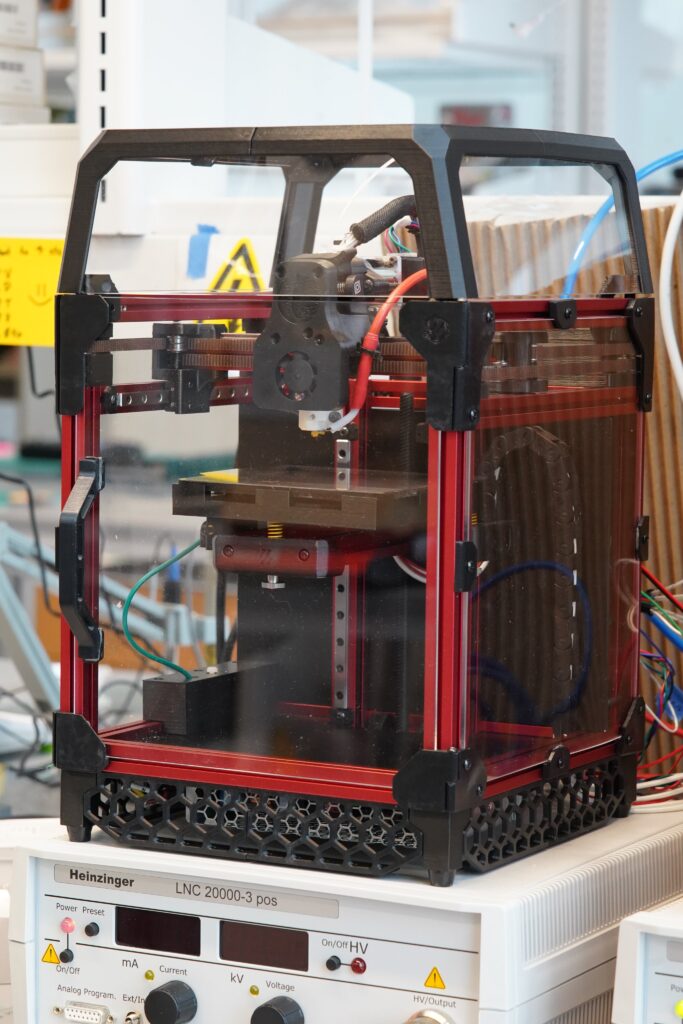Through my years-long obsession with polycaprolactone (PCL), I’ve followed melt electrowriting (MEW), but while it has progressed it never really blew up. I was therefore overjoyed when we came across an amazing new development from the University of Oregon. Associate Professor Paul Dalton and his team at the Dalton Lab have developed an open source MEW 3D printer that could make the technology a lot more widespread and relevant to industry at large.
What is Melt Electrowriting?
Currently quite an unknown technology, MEW is a high-resolution technique that precisely deposits fiber and extrudes material using a combination of syringe or filament extrusion and electro-hydrodynamic fiber attraction. That is, an electric field draws the material out of the deposition head. As a new technology, it could have far reaching consequences.
“Could have” is the operative phrase, since the equipment is scarce and cost-prohibitive. While there is a merry band of researchers working on MEW worldwide, masked stereolithography (mSLA) and the grab bag of direct writing in general seem to garner much more attention from the research community currently. Electrospining is gaining in popularity, as is melt electro spinning. However, MEW is seen as just one option among them. MEW is also less photogenic than other print processes and I really believe this is retarding it. Someone should get more photos and slow-motion videos made of the process.
Nevertheless, MEW could be a breakthrough technology in tissue engineering, scaffolding, nano fibers, cartilage, clothing and more. By combining polymers with directed fiber alignment and placement, the process could accomplish tasks other technologies could never accomplish. If we look at cartilage, for example, it’s a incredibly complex complicated arrangement of composite materials. It’s hard to see how we could achieve the 3D printing of such a material via another technology.
Dalton’s Developments in Low-Cost MEW
Dalton—along with researchers Simon Luposchainsky Paula G., Ander Reizabal, Sönke Menke and Taavet Kangur from the University of Oregon Phil and Penny Knight Campus for Accelerating Scientific Impact at the the Swiss École polytechnique fédérale de Lausanne (EPFL)—has developed an open source MEW 3D printer that costs less than $1,000 to build. The designs do not include the high-voltage power supply needed for MEW, but most everything else is included. Made by the MEW community, this is not a toy, but a fully-fledged research device that radically democratizes MEW research.
¨it’s more capable than the most expensive commercial system, at 1/50th the cost. It’s an open access system that you build on your own – based on the brilliant, fully documented and modifiable Voron platform,” Paul Dalton said on LinkedIn.
Voron is an open source community dedicated to production-grade MEW systems based on CoreXY, Klipper firmware, and extruded profiles for the chassis. Where RepRap has focused on making self-replicating machines and improving the accessibility of 3D printers, Voron aims to let you have a slicker more capable system most of all. It’s kind of a new technology stack for 3D printing that competes with the previous, belt-based Marlin stack.
The new open source MEW 3D printer is dubbed the MEWron. Based on the Voron 1.0 3D printer, it can be completed with a syringe or filament extrusion head, featuring a ceramic heater block, a high voltage wire, and electrified print head. This enables the production of fibers as thin as 0.9µm atop an electrified build plate within a 25 X 25 X 40mm build volume.
¨Filament opens MEW opportunities for new materials, with a 50-55µL hot zone that reduces the effects of thermal degradation compared to standard syringes,” Dalton says. Soon, a paper will be released that details the build and demonstrates how “intellectual freedom drives innovation. How open-source hardware drives down costs and increases accessibility.¨
Started in 2015 Voron was founded by RCF, proprietor of a company, now closed, called MZBot. Fueled by Reddit, the Voron community has grown slowly when compared to the more prevalent Prusa printers. However, the system´s capabilities have been making it more relevant as of late. I think that it’s fantastic that the 3D printing industry has multiple technology stacks and architectures. I particularly like the fact that there’s a Voron registry that catalogues the builds.
The registry shows about 2,500 printers total and the subreddit has 18,000 members. Voron is centrally directed, however, so there are few outside resources covering it apart from TeamFDM, but it’s growing. There is a nascent market for open source, low-cost, highly accurate medical devices and research tools. This segment alone would keep the Voron peeps very busy.
We don’t yet know what the impact of this 3D printer will be. Could it be a watershed moment for MEW? Even if it is not, this could be a path forward for democratizing research through open source tools.
Subscribe to Our Email Newsletter
Stay up-to-date on all the latest news from the 3D printing industry and receive information and offers from third party vendors.
You May Also Like
3D Printing Unpeeled: New Arkema Material for HP, Saddle and Macro MEMS
A new Arkema material for MJF is said to reduce costs per part by up to 25% and have an 85% reusability ratio. HP 3D HR PA 12 S has been...
3D Printing News Briefs, January 20, 2024: FDM, LPBF, Underwater 3D Printer, Racing, & More
We’re starting off with a process certification in today’s 3D Printing News Briefs, and then moving on to research about solute trapping, laser powder bed fusion, and then moving on...
3D Printing Webinar and Event Roundup: December 3, 2023
We’ve got plenty of events and webinars coming up for you this week! Quickparts is having a Manufacturing Roadshow, America Makes is holding a Member Town Hall, Stratafest makes two...
Formnext 2023 Day Three: Slam Dunk
I’m high—high on trade show. I’ve met numerous new faces and reconnected with old friends, creating an absolutely wonderful atmosphere. The excitement is palpable over several emerging developments. The high...
































